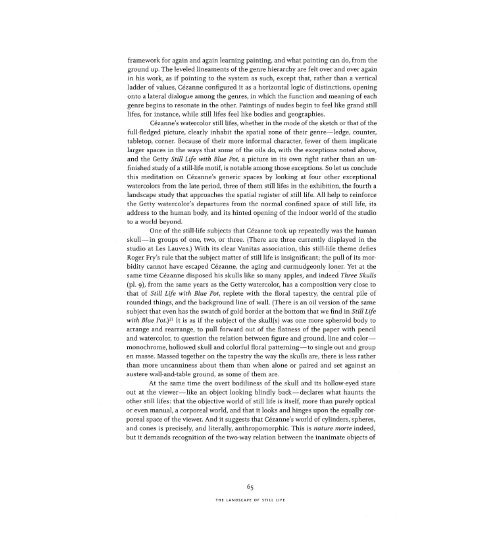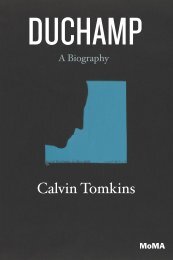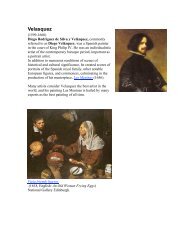Still Life in Watercolors
qbj8dgc
qbj8dgc
- No tags were found...
You also want an ePaper? Increase the reach of your titles
YUMPU automatically turns print PDFs into web optimized ePapers that Google loves.
framework for aga<strong>in</strong> and aga<strong>in</strong> learn<strong>in</strong>g pa<strong>in</strong>t<strong>in</strong>g, and what pa<strong>in</strong>t<strong>in</strong>g can do, from the<br />
ground up. The leveled l<strong>in</strong>eaments of the genre hierarchy are felt over and over aga<strong>in</strong><br />
<strong>in</strong> his work, as if po<strong>in</strong>t<strong>in</strong>g to the system as such, except that, rather than a vertical<br />
ladder of values, Cézanne configured it as a horizontal logic of dist<strong>in</strong>ctions, open<strong>in</strong>g<br />
onto a lateral dialogue among the genres, <strong>in</strong> which the function and mean<strong>in</strong>g of each<br />
genre beg<strong>in</strong>s to resonate <strong>in</strong> the other. Pa<strong>in</strong>t<strong>in</strong>gs of nudes beg<strong>in</strong> to feel like grand still<br />
lifes, for <strong>in</strong>stance, while still lifes feel like bodies and geographies.<br />
Cezanne's watercolor still lifes, whether <strong>in</strong> the mode of the sketch or that of the<br />
full-fledged picture, clearly <strong>in</strong>habit the spatial zone of their genre—ledge, counter,<br />
tabletop, corner. Because of their more <strong>in</strong>formal character, fewer of them implicate<br />
larger spaces <strong>in</strong> the ways that some of the oils do, with the exceptions noted above,<br />
and the Getty <strong>Still</strong> <strong>Life</strong> with Blue Pot, a picture <strong>in</strong> its own right rather than an unf<strong>in</strong>ished<br />
study of a still-life motif, is notable among those exceptions. So let us conclude<br />
this meditation on Cezanne's generic spaces by look<strong>in</strong>g at four other exceptional<br />
watercolors from the late period, three of them still lifes <strong>in</strong> the exhibition, the fourth a<br />
landscape study that approaches the spatial register of still life. All help to re<strong>in</strong>force<br />
the Getty watercolor's departures from the normal conf<strong>in</strong>ed space of still life, its<br />
address to the human body, and its h<strong>in</strong>ted open<strong>in</strong>g of the <strong>in</strong>door world of the studio<br />
to a world beyond.<br />
One of the still-life subjects that Cézanne took up repeatedly was the human<br />
skull—<strong>in</strong> groups of one, two, or three. (There are three currently displayed <strong>in</strong> the<br />
studio at Les Lauves.) With its clear Vanitas association, this still-life theme defies<br />
Roger Fry's rule that the subject matter of still life is <strong>in</strong>significant; the pull of its morbidity<br />
cannot have escaped Cézanne, the ag<strong>in</strong>g and curmudgeonly loner. Yet at the<br />
same time Cézanne disposed his skulls like so many apples, and <strong>in</strong>deed Three Skulls<br />
(pi. 9), from the same years as the Getty watercolor, has a composition very close to<br />
that of <strong>Still</strong> <strong>Life</strong> with Blue Foi, replete with the floral tapestry, the central pile of<br />
rounded th<strong>in</strong>gs, and the background l<strong>in</strong>e of wall. (There is an oil version of the same<br />
subject that even has the swatch of gold border at the bottom that we f<strong>in</strong>d <strong>in</strong> <strong>Still</strong> <strong>Life</strong><br />
with Blue Pot) 21 It is as if the subject of the skull(s) was one more spheroid body to<br />
arrange and rearrange, to pull forward out of the flatness of the paper with pencil<br />
and watercolor, to question the relation between figure and ground, l<strong>in</strong>e and color—<br />
monochrome, hollowed skull and colorful floral pattern<strong>in</strong>g—to s<strong>in</strong>gle out and group<br />
en masse. Massed together on the tapestry the way the skulls are, there is less rather<br />
than more uncann<strong>in</strong>ess about them than when alone or paired and set aga<strong>in</strong>st an<br />
austere wall-and-table ground, as some of them are.<br />
At the same time the overt bodil<strong>in</strong>ess of the skull and its hollow-eyed stare<br />
out at the viewer—like an object look<strong>in</strong>g bl<strong>in</strong>dly back—declares what haunts the<br />
other still lifes: that the objective world of still life is itself, more than purely optical<br />
or even manual, a corporeal world, and that it looks and h<strong>in</strong>ges upon the equally corporeal<br />
space of the viewer. And it suggests that Cezanne's world of cyl<strong>in</strong>ders, spheres,<br />
and cones is precisely, and literally, anthropomorphic/This is nature morte <strong>in</strong>deed,<br />
but it demands recognition of the two-way relation between the <strong>in</strong>animate objects of<br />
65<br />
THE LANDSCAPE OF STILL LIFE




